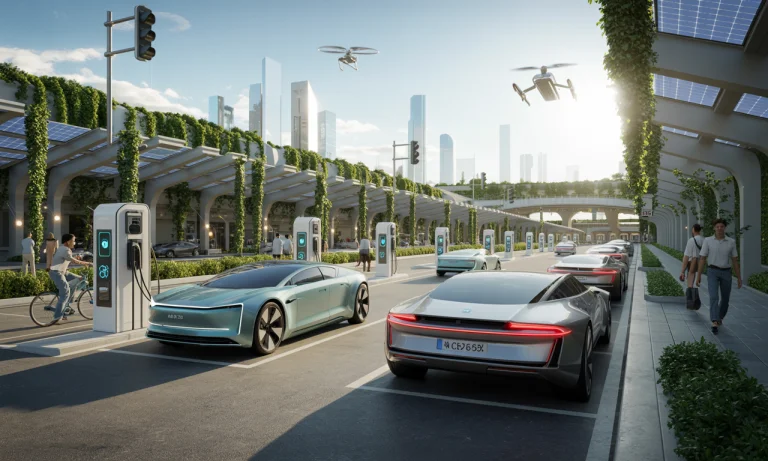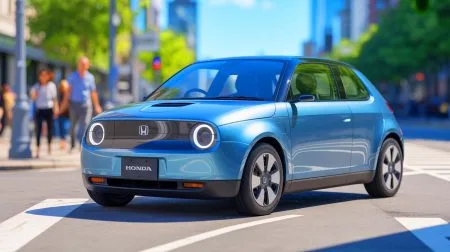The automotive world has entered a new era. On the bustling streets of New York, a young professional named Marcus quietly powers up his Hyundai, while families in Texas cruise in silent luxury aboard Lucid Motors’ latest SUV. Dealerships, once lined with gas-guzzling titans, now find their showrooms electrified by cutting-edge rivals. By 2025, electric cars are no longer the promise of tomorrow—they’re the reality of today. Range anxiety fades as fast-charging stations dot highways. Tech enthusiasts marvel at Tesla’s relentless innovation, while Rivian and BYD slip into conversations once reserved for Ford or Volkswagen. For every buyer—from the daily commuter to the adventure-seeking parent—the spectrum of choices has exploded. Whether you’re drawn to a modest Chevrolet or crave the thrill of a Porsche Macan EV, the roads ahead promise excitement, practicality, and sustainable progress. In this shifting landscape, understanding key trends helps every driver navigate the choices awaiting them.
Electric Cars Shaping the Future: What’s New on the Road in 2025?
Across the globe, the launch of new electric vehicles reads like a glimpse into the future. Tesla fine-tunes its Model 3, delivering sleek aerodynamics and even smarter technology. Over at Lucid Motors, the Gravity SUV impresses with 440 miles of range and a tri-motor variant rivaling supercars. Rivian expands its lineup, rolling out the affordable R2 and the rugged R3X, tailored for both city dwellers and trail blazers. Ford brings its Explorer EV—built on Volkswagen’s MEB platform—catering to families without sacrificing innovation. On the other side of the Atlantic, Volkswagen‘s ID. Buzz GTX stirs nostalgia, reimagining the microbus for digital-age road trips. Each name has a story: BYD’s bold leap into North American markets, Hyundai’s all-new Ioniq 9 stretching the boundaries of practicality, and Nissan’s Ariya Nismo proving that EVs can excite. These electrifying entries underscore how the dawn of 2025 is simply a new chapter in the ongoing saga of automotive evolution.
| Model | Brand | Estimated Range (miles) | Unique Feature |
|---|---|---|---|
| Model 3 | Tesla | 340+ | Improved tech & aerodynamics |
| Gravity | Lucid Motors | 440 | Tri-motor, rapid charging |
| R2 | Rivian | 300 | Affordable adventure SUV |
| Explorer EV | Ford | ~300 | VW platform, spacious |
| ID. Buzz GTX | Volkswagen | 260 | Retro microbus, AWD |
| Seal | BYD | 300-400 | Affordable, global expansion |
Behind the Wheel: How Electric Cars Are Changing the Everyday Commute
For city dwellers like Marcus, hopping into an EV every morning is no longer a futuristic fantasy. Now, Hyundai, Kia, and Chevrolet lead the charge for commuters craving efficiency. Commuting isn’t simply about getting from A to B. For many, it becomes a quiet revolution—traffic stress replaced by the mellow hum of an electric drive, while regenerative braking captures kinetic energy at every stoplight. Models such as the Chevrolet Equinox EV and Hyundai Ioniq 9 offer intuitive tech, advanced driver aids, and fast-charging capabilities that make spontaneous getaways possible. Ford’s F-150 Lightning pickup, though launched earlier, continues to influence how work and lifestyle vehicles adapt to new electric realities. Choices like the affordable BYD Dolphin bring EVs within reach for budget-conscious consumers. The roads feel different now—cleaner, calmer, more connected—reclaiming the daily drive as an experience worth savoring.
EV Technology Advancements: Performance, Range & Charging Speeds in 2025
In the quest for wider EV adoption, the race for superior battery technology dominates the conversation. Industry leaders—from Kia to Chevrolet—embrace ultra-fast charging. A stop at a highway charger now mirrors the convenience of a traditional fuel break, with vehicles like the Lucid Gravity and GMC Sierra EV utilizing high-voltage architectures. Tesla continues to refine its network, while Volkswagen integrates software-driven route optimization. Battery range is no longer a luxury: models such as the Audi A6 e-tron deliver up to 435 miles, while affordable options still comfortably cross the 250-mile threshold. Behind the scenes, companies quietly roll out heat pump systems for better efficiency in cold climates, and regenerative braking evolves to provide not just longer range but smoother stopping power. For many, it’s no longer about range anxiety—it’s about the convenience, performance, and surprising fun that new EVs bring behind the wheel.
| Brand | Charging Network | Max Charging Speed (kW) | Heat Pump Tech? |
|---|---|---|---|
| Tesla | Supercharger V4 | 350 | Yes |
| Rivian | Adventure Network | 300 | Standard |
| Hyundai | Ultra-fast E-GMP platform | 350 | Yes |
| Volkswagen | Electrify America/Europe | 320 | Yes |
| Chevrolet | Ultium Charge 360 | 250 | In select models |
The EV Experience: Design, Connectivity, and Safety Features
Electric cars have transformed not only the driving experience but the cabin itself. Lucid Motors and Tesla set benchmarks with minimalist dashboards and seamless connectivity, integrating entertainment options as never before. Many follow suit—Ford, Nissan, and BYD equip vehicles with next-gen infotainment, augmented reality displays, and sophisticated driver aids. Some brands, like Polestar and Genesis, turn to sustainable materials, blending eco-conscious luxury with family practicality. Within minutes, Marcus discovers the world’s traffic in a tap—routes, music, news, all harmonized through his Ioniq 9. Safety evolves, too: from Volvo’s integrated lidar to Volkswagen’s swarm AI data, insurance risks feel distant. As cars become smarter, they also become safer, more comfortable, and—perhaps most importantly—more enjoyable for every passenger.
The Market Landscape: EV Brands to Watch and Practical Tips for 2025 Car Buyers
The dynamism of 2025’s EV market is best told through its cast of innovators. Tesla leads, but new chapters are written by Rivian, BYD, Kia, and Lucid Motors. Traditional giants like Ford and Chevrolet constantly reimagine icons, offering hybrids of nostalgia and modernity. For those seeking to buy, markets teem with advice. Prospective owners weigh the merits of electric vs. gas cars (read this analysis), investigate how to maximize resale value (see these tips), and learn how to test drive and select a new EV (practical advice here). Even the frugal compare the cheapest yet most reliable electric cars, monitoring incentives and total cost of ownership (explore further). Marcus, for instance, discovered substantial maintenance savings, further underscoring the shift from combustion to electrification. The narrative continues, with real stories from everyday drivers reshaping consumer priorities.
| Shopping Tip | 2025 Recommendation | Helpful Link |
|---|---|---|
| Comparing EV and Gas Vehicles | Assess charging network, daily range, incentives | See comparison |
| Test Driving an EV | Focus on quietness, instant torque, controls | Review tips |
| Boosting Resale Value | Choose brands with OTA updates, strong after-sales | Boost value |
| Saving on Repairs | Learn DIY basics, use official service points | More info |
Adapting to an Electrified World: Life Beyond the Steering Wheel
Every aspect of daily life adapts as electrification spreads. Urban planners redesign intersections for quieter traffic. Rural communities edged by sprawling highways now see Ford, Nissan, and BYD quietly replace decades-old pickups. Charging at the office or on family vacations becomes routine, integrated seamlessly into the rhythm of modern living. Local businesses benefit from the growing demand for fast chargers, as seen in recent industry reports. The transition sparks new conversations about energy sustainability and personal responsibility. For Marcus and millions of others, the journey goes beyond a personal car—it’s a movement reshaping cities, economies, and aspirations for generations to come.
Frequently Asked Questions about Electric Cars in 2025
Which electric car brands offer the best value for range and price in 2025?
Rivian, Hyundai, Kia, and BYD provide strong value with models like the R2, Ioniq 9, and EV9. Tesla and Chevrolet remain popular for their efficiency and widespread service networks. To explore current offers, visit LeftLaneNews.
How easy is it to charge an EV on long-distance trips now?
Fast-charging networks have expanded rapidly. Tesla, Volkswagen, Rivian, and Hyundai offer integrated route planning and charging stations nearly as common as fuel stops. For road trip planners, check recent charging network news.
Are electric cars cheaper to maintain compared to traditional vehicles?
Maintenance costs are typically lower for EVs due to fewer moving parts and no oil changes. Real-world examples show drivers saving significantly on repairs; see advice on repair savings.
What incentives can buyers expect when purchasing a new EV in 2025?
Incentives vary by region, but federal and local rebates can greatly reduce upfront costs. Many U.S.-built EVs, such as those from Ford or Chevrolet, are eligible for the full tax credit. For the latest updates, consult this buyer’s resource.
How do I choose between an electric and a gas car in 2025?
Compare daily travel needs, charging convenience, and long-term maintenance costs. Electric vehicles now match or surpass gas cars in performance and running costs. Get decision support and side-by-side comparisons here.
Did you like it? 4.4/5 (23)







